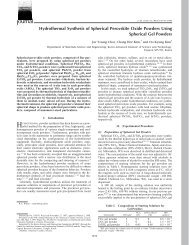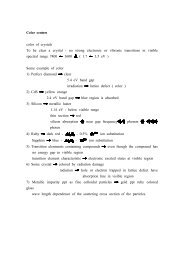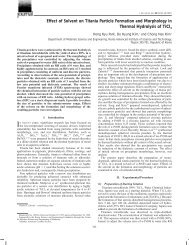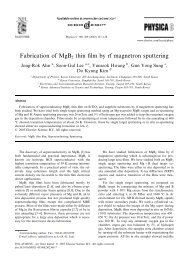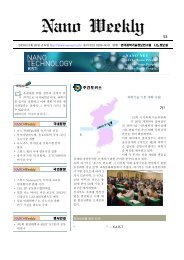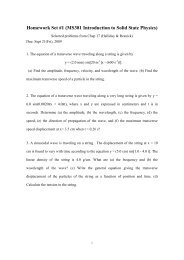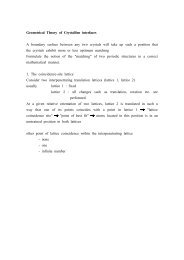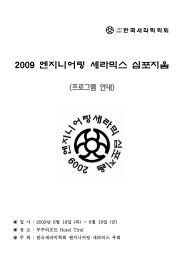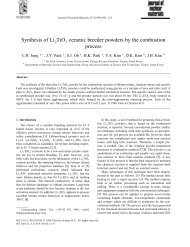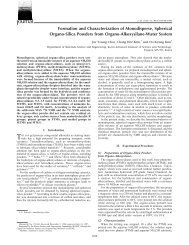Dislocation Model of Grain Boundaries Hirth and Lothe : chapter 19 ...
Dislocation Model of Grain Boundaries Hirth and Lothe : chapter 19 ...
Dislocation Model of Grain Boundaries Hirth and Lothe : chapter 19 ...
Create successful ePaper yourself
Turn your PDF publications into a flip-book with our unique Google optimized e-Paper software.
<strong>Dislocation</strong> <strong>Model</strong> <strong>of</strong> <strong>Grain</strong> <strong>Boundaries</strong><br />
<strong>Hirth</strong> <strong>and</strong> <strong>Lothe</strong> : <strong>chapter</strong> <strong>19</strong><br />
<strong>Grain</strong> boundaries can be constructed by placing the two misoriented crystal<br />
together along the desired grain boundary place rigidly in a st<strong>and</strong>ard reference<br />
position <strong>and</strong> then relaxing the entire ensemble.<br />
In this process, the atoms in the boundary region will relax their positions to<br />
minimize the total energy by a rigid body translation without rotation ( )<br />
In general, eight geometric parameters are required to give a complete<br />
macroscopic specification <strong>of</strong> a grain boundary<br />
3 parameters - crystal orientation<br />
2 parameters - orientation <strong>of</strong> boundary<br />
3 parameters - rigid translation <strong>of</strong> crystal 2 with respect to crystal 1.<br />
: rotation axis<br />
θ<br />
The orientation <strong>of</strong> the boundary<br />
3 parameters<br />
a unit vector normal to the boundary plane
2 parameters<br />
has 3 components 3 parameters<br />
Tilt boundary : boundary plane is parallel to ( )<br />
Twist boundary : boundary plane is perpendicular to<br />
mixed boundary : intermediate case<br />
( )<br />
simple boundaries<br />
a) (100) symmetric tilt boundary<br />
: dislocation separation distance<br />
In tilt boundary tilt angle θ is fixed then will be fixed<br />
All (100) planes intersecting the surface region<br />
within ABC must end as incomplete planes<br />
at the boundary<br />
number <strong>of</strong> incomplete planes<br />
mean separation between dislocations<br />
for small angle θ<br />
θ<br />
b) (100) non-symmetric tilt boundary<br />
θ<br />
θ
φ : angle between the tilt boundary <strong>and</strong> symmetry boundary<br />
Two set <strong>of</strong> dislocations are required to construct even a simple boundary.<br />
In the present case, both (100) <strong>and</strong> (010) planes must terminate in the boundary,<br />
thus dislocations <strong>of</strong> both sets <strong>and</strong> are present<br />
similarly<br />
ψ<br />
θ<br />
θ ψ<br />
ψ<br />
θ θ<br />
θ ψ<br />
arbitrary large angle boundary<br />
Frank's formula<br />
recall definition <strong>of</strong> Burgers vector in perfect reference crystal<br />
Net dislocation density in an arbitrary small angle boundary<br />
consider a wall containing several sets <strong>of</strong> dislocations<br />
in each set dislocations<br />
parallel<br />
every spaced<br />
same burgers vector<br />
ψ
: a vector in the GB in terms <strong>of</strong> crystallographic coordinates <strong>of</strong> grain<br />
A<br />
: the same vector in terms <strong>of</strong> crystallographic coordinates <strong>of</strong> grain B<br />
if there should be no in the wall, <strong>and</strong> should be identical<br />
In terms <strong>of</strong> sets <strong>of</strong> dislocations<br />
-<br />
: number <strong>of</strong> dislocations <strong>of</strong> burgers vector cut by<br />
The above equation valid for wall <strong>of</strong> dislocations<br />
If has positive component along ξ ( : a unit normal to the boundary<br />
pointing from grain A to grain B )<br />
a dislocation cut by is counted as a positive contribution to<br />
If the dislocation wall is true grain boundary crystal B is merely rotated with<br />
respect to crystal A <strong>and</strong> not deformed.<br />
For small angle rotation<br />
θ ( : a unit vector along axis <strong>of</strong> rotation)<br />
θ should be small, θ θ<br />
θ -<br />
equation <strong>and</strong> : Frank's formula
Arbitrary large-angle boundary<br />
The same as previous case<br />
burgers circuit<br />
Take circuit in right h<strong>and</strong>ed manner about<br />
In fig <strong>19</strong>-18 (a)<br />
A crystal : rotation θ from reference crystal<br />
B crystal : rotation θ from reference crystal<br />
: in boundary plane<br />
<strong>and</strong> = rotation by θ <strong>and</strong> θ with respect to<br />
θ θ θ<br />
Burgers circuit in fig. b closure failure<br />
in fig. b the same as equation<br />
For a given grain boundary, reference crystal can be oriented such that the grain<br />
boundary is produced by rotations θ θ θ ( fig. c)
then<br />
rotation matrix for A <br />
<br />
<br />
rotation matrix for B <br />
<br />
<br />
From equation Frank's formula<br />
θ<br />
θ θ <br />
<br />
θ θ<br />
<br />
θ θ <br />
<br />
θ θ<br />
<br />
θ θ θ θ<br />
θ θ θ θ<br />
θ θ θ
<strong>Dislocation</strong> spacing in the boundary<br />
By introduction <strong>of</strong> a reciprocal vector notation, Frank's formula for general GB<br />
can be reduced to convenient parametric expressions for dislocation density<br />
: dislocation spacing between boundary dislocation<br />
: number <strong>of</strong> dislocation/unit length in directioni normal to ξ<br />
ξ : sense vector <strong>of</strong> dislocation type<br />
: reciprocal vector lying in the boundary <strong>and</strong> perpendicular to ξ<br />
ξ<br />
ξ<br />
Determination <strong>of</strong> for a given <strong>and</strong><br />
from <strong>and</strong><br />
θ<br />
θ -<br />
-<br />
If this equation is satisfied for two independent direction <strong>of</strong> , it is satisfied for<br />
all in the boundary.<br />
With a given <strong>and</strong> , equation constitute 6 equations for determination<br />
<strong>of</strong> values <strong>of</strong><br />
For the case <strong>of</strong> 3 sets <strong>of</strong> dislocations with independent Burgers vectors, 3<br />
value represent 6 unknowns (as each has two components in the boundary)<br />
Thus for 3 independent , can be uniquely defined.
This is equivalent to considering a mixed boundary as a mixture <strong>of</strong> a tilt<br />
boundary<br />
(1 set) <strong>and</strong> a twist boundary (2 sets)<br />
Given <strong>and</strong> 3 independent , the solution for is as follows<br />
Define reciprocal lattice vector as<br />
δ<br />
multiplying equation by gives<br />
Since is any vector in the boundary, is component <strong>of</strong> in the<br />
boundary<br />
Note that the long range stress fields <strong>of</strong> the primary dislocations essentially fall<br />
to zero at distances from the boundary larger than about the wavelength <strong>of</strong> the<br />
boundary.
<strong>Grain</strong> boundary energy<br />
Read <strong>and</strong> Shockley (<strong>19</strong>50)<br />
assume<br />
small angle symmetric tilt boundary<br />
isotropic (elastically)<br />
dislocation spacing<br />
for small θ<br />
θ θ<br />
energy/unit length <strong>of</strong> edge disloaction<br />
μ<br />
π ν<br />
: extent <strong>of</strong> dislocation stress field<br />
μ<br />
π ν θ<br />
number <strong>of</strong> dislocation/unit length
: energy/unit area <strong>of</strong> boundary<br />
θ<br />
π ν θ<br />
μ<br />
π ν<br />
π ν<br />
μ<br />
for twist boundary<br />
μ<br />
π<br />
π<br />
μ<br />
θ<br />
θ θ γ<br />
When the boundary contains several arrays <strong>of</strong> dislocations the same form <strong>of</strong><br />
γ can be expected<br />
consider the symmetric tilt boundary<br />
: energy associated with a strip<br />
( )<br />
suppose boundary misorientation decreases by θ , leading to increases in <strong>and</strong><br />
given by<br />
θ<br />
θ
change <strong>of</strong><br />
If dislocation spacing is large enough , does not change<br />
: volume <strong>of</strong> strip increases but elastic energy density decreases<br />
elastic energy density (elastic strain) 2<br />
elastic energy density<br />
cylindrical element <strong>of</strong> area<br />
: stress in this region depends on only the included dislocation<br />
elastic energy density does not change<br />
radius <strong>of</strong> the cylinder<br />
The elastic stress field in the increased area<br />
increase <strong>of</strong> radius <strong>of</strong> the cylinder :<br />
increase <strong>of</strong> area <strong>of</strong> slip plane by<br />
stress in any point : τ<br />
work done τ<br />
τ τ<br />
integration <strong>of</strong> the above equation<br />
τ θ<br />
energy/unit area <strong>of</strong> boundary γ<br />
γ τ θ θ<br />
If boundary contains more than one array <strong>of</strong> dislocations<br />
the arrays should be considered.<br />
interaction between<br />
From above, interaction energy contributes only to elastic strain energy for<br />
each array<br />
The interaction energy absorbed into the constants <strong>of</strong> integration<br />
Then, γ θ θ<br />
θ<br />
θ
In this derivation - is uniformly spaced<br />
(This is possible, dislocation spacing corresponds to some crystal repeat distance)<br />
Uniformly spaced dislocations occur only at particular misorientation.<br />
For intermediate angles, irregularities in dislocation spacings introduce additional<br />
terms in energy (a partial type dislocation)<br />
For small derivation δθ from the nearest rational angle θ<br />
(for rotation about axis in cubic crystal<br />
extra energy is <strong>of</strong> order<br />
δθ<br />
δθ ( Burgers vector : )<br />
δθ , slope<br />
γ<br />
θ<br />
becomes infinite
The above treatment is valid only for low angle boundary (10 15°)<br />
Wolf's observation<br />
Computer simulation for relaxed grain boundary energy at 0 K.<br />
for several series <strong>of</strong> boundary, tilt <strong>and</strong> twist angle varied.<br />
common features as follows<br />
Read-Shockley formula fitted very well to the calculated results for the entire<br />
misorientation range when θ was replaced to θ.<br />
γ θ θ θ<br />
according to Frank's formula, at large angle θ,
θ can be replaced as<br />
θ but no θ



